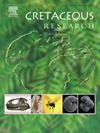The early evolutionary and biogeographical history of Gondwanan iguanodontian dinosaurs is poorly understood due to their scarce Lower Cretaceous fossil record. In South America, the Lower Cretaceous iguanodontian osteological record is very fragmentary and most published reports cannot be used to discard or confirm hadrosauroid affinities. The single exception is Tietasaura from Brazil, whose incomplete femur shows a combination of traits found only in non-hadrosauroid iguandontians. Furthermore, no skeletal remains whatsoever of Lower Cretaceous iguanodontians have been reported from the western margin of South America. Here, we describe an isolated ornithopod caudal centrum (SGO.PV.22900) from the Lower Cretaceous Quebrada Monardes Formation in the Atacama Desert, northern Chile. Although incomplete, SGO.PV.22900 presents iguanodontian traits, such as the sub-hexagonal contour of the articular faces, the rectangular profile in lateral view and the absence of transverse processes below the neurocentral suture. We were also able to use quantitative measurements to explore taxonomic affinities, by carrying out a Linear Discriminant Analysis (LDA) and a Principal Components Analysis (PCA) using measurements of caudal centra of several iguanodontian species. The results of both analyses are consistent with those of our comparisons and suggest that SGO.PV.22900 belongs to a non-hadrosauroid iguanodontian ornithopod. This specimen represents one of the most compelling and best documented pieces of osteological evidence of Lower Cretaceous non-hadrosauroid iguanodontian dinosaurs in South America and provides further support for the presence of iguanodontians in the southwestern margin of Gondwana since at least the Early Cretaceous, as previously suggested based on footprints.


